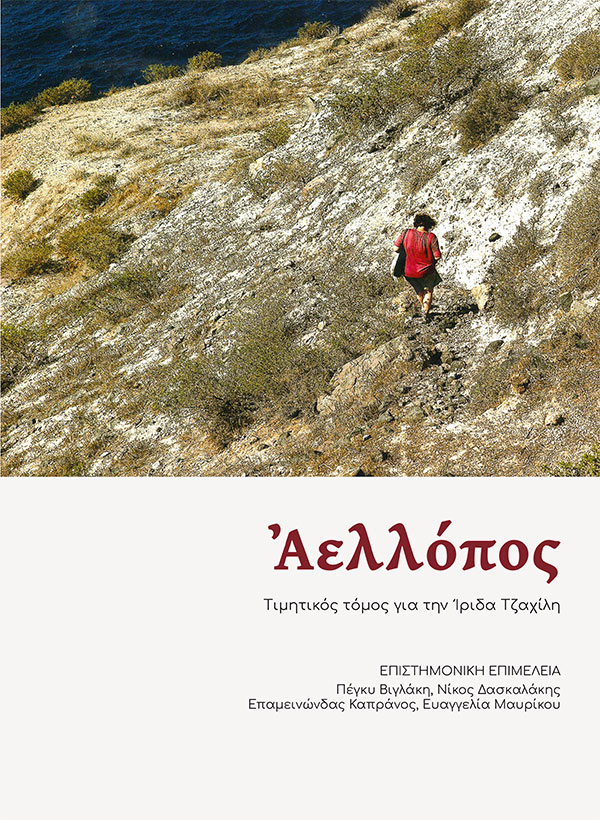|

List of contents - Introduction (PDF) >>
Order this book >>
|
Aellopos, Studies in Honour of Iris Tzachili. (Ta Pragmata Press, 2023)
Edited by:
Peggy Viglaki, Nikos Daskalakis, Epaminondas Kapranos, Evangelia Mavrikou
ISBN 978-960-98261-9-8 pp. 546
Aellopos, Studies in Honour of Iris Tzachili is a collection of 35 studies dedicated
to Iris Tzachili, Professor Emerita of Prehistoric Archaeology of the University of Crete. The authors are mainly her students together with many of her colleagues,
archaeologists and historians, from Crete, Thera and the Department of History and Archaeology of the University of Crete. The thematically and chronologically
multifaceted studies deal with archaeological and historical issues, as well as highlighting the historicity of heritage and contemporary reception.
The studies in this volume are classified in sections according to Iris Tzachili's academic and
teaching contribution, while they also raise contemporary archaeological questions, both scientific and social. To give a brief overview of the contents,
the first section deals with textiles in antiquity, a relatively new research topic that has sparked great archaeological interest, offering a multitude
of methodological fields, both technical (Spantidaki and Moulherat) and iconographic (Karanastasi, Kekes, Boloti, Vakirtzi).
A second favourite theme is landscape as a human conception following anthropogenic interventions to the space, as visual realisation and as nomenclature
(Karamaliki, Athanasiou, Palyvou, Boufalis). This subject chiefly touches on the notion of homeland, which is defined by both its idealised and its actual
landscapes (Hatziiosif, Moustakas). Meanwhile, modern field surveys offer a scientific technique for approaching space in the sense of the longue duree
(Sbonias and Farinetti) or the historicity of urban landscapes (Gratziou).
The subject of rituals and their possible modes of representation is a rich one,
stimulating thought and interpretations. The relationship of the image to the movement or the discourse of the cultic ritual is traced in representations
that have been regarded as associated with religion (Alexopoulos, Boulotis, Mavroudi, Sfakianakis, Fakarou). The relationship between prehistoric beliefs
and Greek mythology is explored (Karagiannakis, Maniki, Svana), while the possibility that peak sanctuary cult began in the Neolithic period is also
investigated (Margarita Papadopoulou). The peak sanctuaries and Vrysinas in particular are the main focus of this section (Eleni Papadopoulou).
The multifaceted, versatile products of material culture are one of the most prominent subjects
of prehistoric and indeed ancient archaeology as a whole. In this section, the authors study the solutions provided to technical matters such as the manufacture
of ceramic vessels (Dovas), the various forms of everyday artefacts (Gavrilaki, Kostanti, Daskalakis, Vogli) and, above all, the stories told about them by others
(Bakalaki). The primary aim is to express their symbolic relationship to cultic events and funerary customs, as these are illuminated in exemplary funerary contexts
(Tegou, Kapranos).
Historical syntheses and events with complex narratives and details that resist interpretation make up
the section dealing with histories and stories, great and small. K. Georgakopoulos presents a synthesis of the scattered testimonies on the peoples of
Western Asia Minor whose geographical location is hard to identify, in particular the Ahhiyawwa. There follows Katerina Panagopoulou's analysis of a Ptolemaic scroll,
raising numismatic questions and the issue of economic transactions. Finally, Aglaia Kasdagli's charismatic account of a Santorini earthquake in 1650/1651 closes the
theme with its subtitle: Zero hour, but the story/history continues.
The relationship between the present and the past is addressed by a study on nationalism in
archaeology (Tzagaraki), while Tanoulas, the restorer of the Propylaea, describes the vicissitudes of the construction sites and the restoration efforts in terms
of visitor traffic and needs. Modern life affects and determines not only the appearance but also the way of viewing.
Ultimately, behind the multiplicity of themes and monuments addressed in the volume, the multiplicity
of approaches to the scientific management of the tangible and intangible past is also highlighted, in no wise independent of modern life. The honorary volume
Aellopos provides the possibility of a thematically fragmentary, but holistic precisely because of this thematic diversity, approach to archaeology as research
and as practice.
|